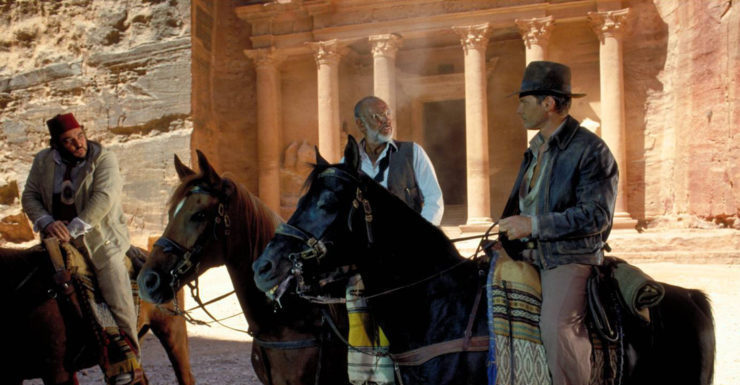I was 13 years old when I first became fascinated by the famous “Lost City” of Petra: about a week after its release, my parents took me to the movie theater and I saw Indiana Jones and the Last Crusade (1989).
Oh man, did I love that movie. Even today it’s in my list of top-ten favorite films. The acting, the direction, the music, the plot, the characterization, and even that meat-slap sound whenever Indy hit a bad guy… dang, I want to punch a Nazi just thinking about it.
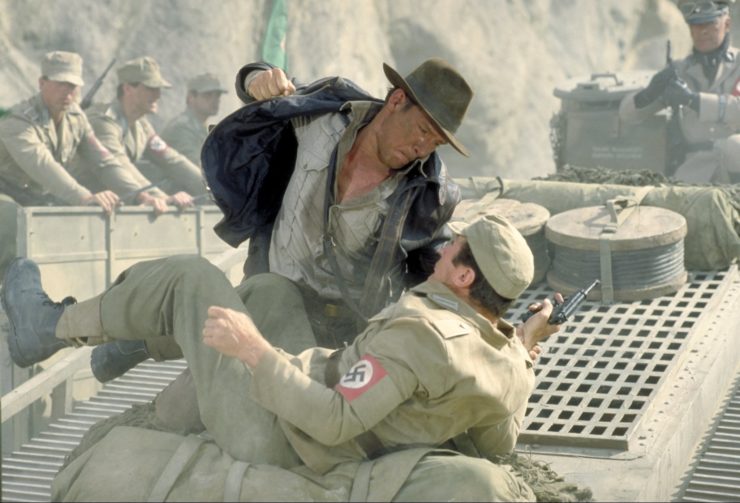
In addition to all that, I thought the incorporation of Real-World things was a fun and wonderful change from the rather fantastical turn of Temple of Doom. I mean, having Indy pop out of a sewer in the middle of a Venetian cafe (“Ah, Venice”) was positively delightful.
And then there’s that sequence near the end, where our hero and his two companions ride through a magnificently thin desert canyon and come upon an ancient ruin cut into the side of a cliff.
Not a CGI ruin. Not a miniature.
A real one.
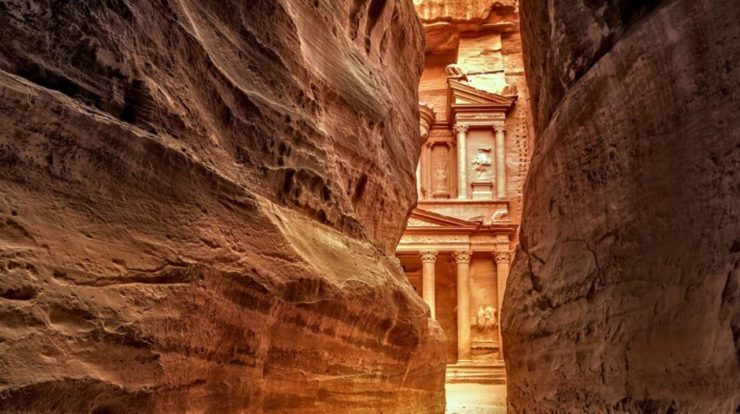
I’d heard of Petra before—when I was a kid our family encyclopedias were stored in my room and, well, I read them—but to see it on film was just jaw-dropping.
So at the ripe ol’ age of 13 I promised myself that I’d go there one day. And that dream remained strong, despite Michael Bay putting another piece of Petra on film in Transformers: Revenge of the Fallen (2009).
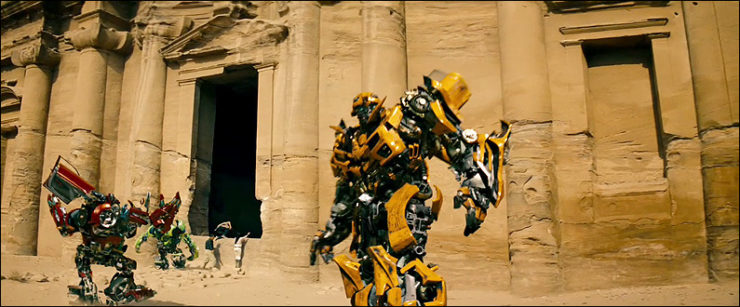
To my great regret, hiking Petra is a bucket list item I’ve not done yet.
I’ve done what I could, though, by going there in spirit… by making it one of two big new ancient locations (the other is Jerusalem) visited by my own set of heroes in The Realms of God, the third and final volume of the Shards of Heaven trilogy.
As fans of the series know, I try hard to get things right. I’m a historian by training, and if I’m going to do the research to try to get Roman military practices correct in my story, you can be damn sure that I’m going to do the same for ancient Alexandria, Rome, Carthage, Cantabria… and, yes, Petra.
There’s obvious research that goes into painting pictures of such ancient places—starting with analyzing every ancient description you can get your hands on—but there are a few unexpected avenues beyond all those books that I found to be enormously useful to my writing.
With NaNoWriMo approaching, I thought I’d let you in on three of the more unusual research tools that I used to build Petra:
1. Google Earth
Thank the gods I live in an age with easy accessibility to satellite images. Whether I’m identifying ancient and medieval battlefields for my day job as a professor or reconstructing places for my night job as a writer, Google Earth is a near-constant presence on my desktop.
Importantly, Google Earth is so much more than just those amazing satellite views: deeper connections to street view and resources like Panoramio can give you tremendous access to what it’s like to stand in a spot once you’ve found it via satellite. Plus there are functions for setting day and night angles of the sun—which, yeah, you can tie to historical dates—and even ways to amplify altitude differentials in order to get a clearer sense of topography.
2. Archaeology
It’s an old but true joke that archaeologists dig the past. And I’m so very glad they do, as the discoveries they make can fundamentally change our understandings of a place. As a writer of historical things, therefore, you’ve got to try to keep abreast of what has been found in the field. Sure, archaeology reports can be a bit of a slog to read, but they can also contain magnificent gems of discovery.
For instance, The Realms of God takes the reader not just into Herod’s Temple in ancient Jerusalem but into what’s called the Well of Souls beneath it (sorry, Indy, it’s not in Tanis). I’ve not been in that real chamber—access is pretty restricted these days—but a few archaeologists have. Their reports, and the great illustrations and photographs that go with them, were a boon to me.
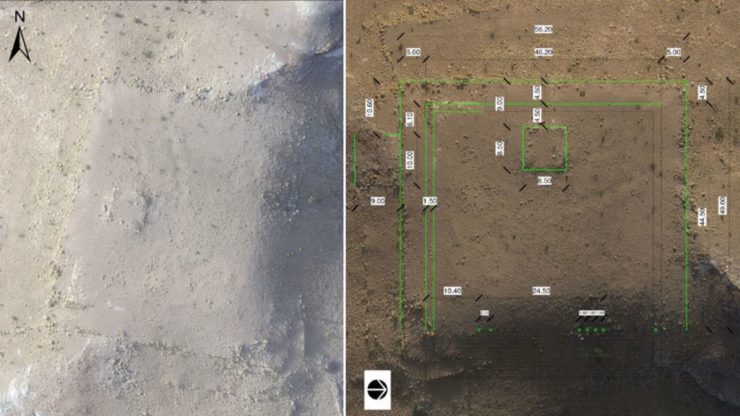
And keep in mind that archaeology is ever-evolving. There’s an early chapter of Realms in which a young girl crosses the land south of Petra on her way to the Tomb of Aaron, the brother of Moses. I wrote the chapter on a Monday, and then on Wednesday I came across news of a new temple discovered just south of the city —discovered, as it happens, using satellite imagery that puts my beloved Google Earth to shame. I immediately contacted one of the archaeologists involved, the exceedingly brilliant Sarah Parcak (who has the best Twitter handle, @indyfromspace). I introduced myself and she generously shared some of their cutting-edge findings. As a result, I not only had to change my character’s route in the book, but I also got to put this previously unknown Temple into fiction for the first time. (And thank you again, Sarah!)
3. YouTube
Yeah, YouTube. Surprising, I know, but it’s not just for funny cat videos. The thing is, for pretty much any site of known significance, you can be sure that at this point someone somewhere has been there and recorded a video selfie of their experience.
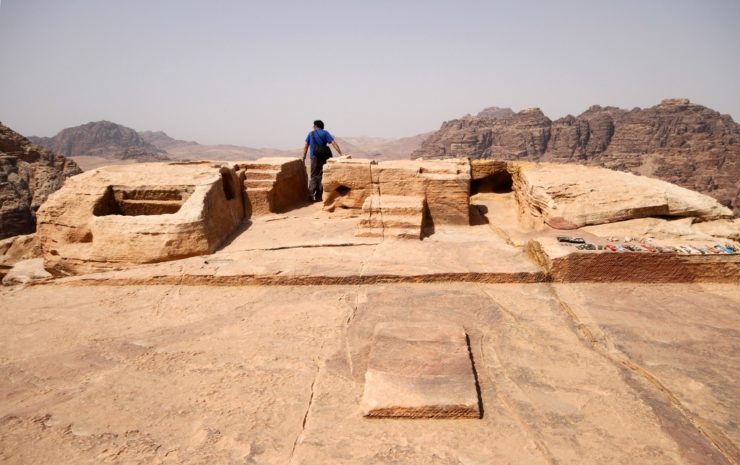
When it came to Petra, for instance, I have a really important sequence that takes place at a site called the High Place of Sacrifice. As I was writing this action sequence I had access to Google Earth imagery, on the ground still-shots (including 360-degree pan imagery), archaeology reports … and a couple of terrific videos of people who recorded their visits to the site. Still-framing one video in particular allowed me to combine it with archaeological data and visual contexts to get dimensional spacing for features not included in any site reports I found.
Put it all together, and you have enormously valuable resources for writing. Here’s my “map scrap” of Petra that I sent to Tor for the new novel:
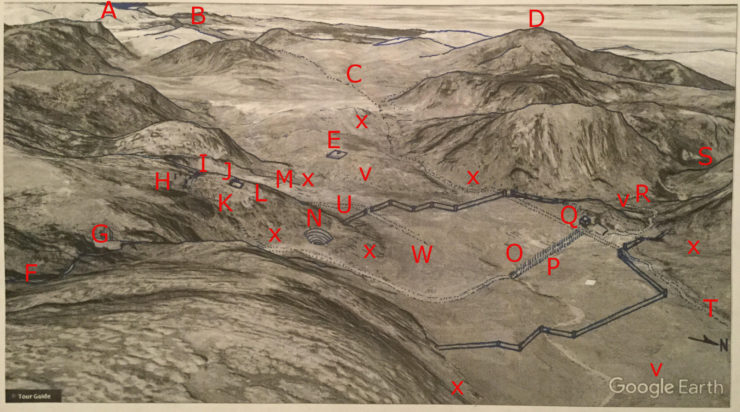
This is a Google Earth shot, with the topography slightly amplified, covered with my rudimentary drawing of some major features of the city and area, then coded to a legend to help the cartographer make sense of it all. The Tomb of Aaron is ‘D’, the new temple discovered by Prof. Parcak is ‘E’, the Treasury is ‘G’, and the High Place of Sacrifice is ‘J’… if you’re following along at home.
In the end, of course, fiction is fiction. My trilogy tells a story of ancient artifacts imbued with elemental powers and the struggle of people trying to keep the world and themselves together. So when I say that I have tried to make the setting as real and historically accurate as possible, know that I mean “as possible” within the context of story.
Still, I tried to get Petra more right than that sequence in The Last Crusade did: that Temple they find at the end of the Siq (that’s the name of the thin canyon) is the tomb of King Obodas III, and it’s relatively simplistic inside that fancy exterior, hardly the complex network of rooms and trapped puzzles that Indy and company found.
But, hey, inspiration is inspiration. Dr. Jones brought me to Petra in my mind. And maybe, hopefully, my work will do the same for some other folks.
 Michael Livingston is a Professor of Medieval Culture at The Citadel who has written extensively both on medieval history and on modern medievalism. His historical fantasy trilogy set in Ancient Rome, The Shards of Heaven, The Gates of Hell, and the newly released The Realms of God, is available from Tor Books.
Michael Livingston is a Professor of Medieval Culture at The Citadel who has written extensively both on medieval history and on modern medievalism. His historical fantasy trilogy set in Ancient Rome, The Shards of Heaven, The Gates of Hell, and the newly released The Realms of God, is available from Tor Books.










